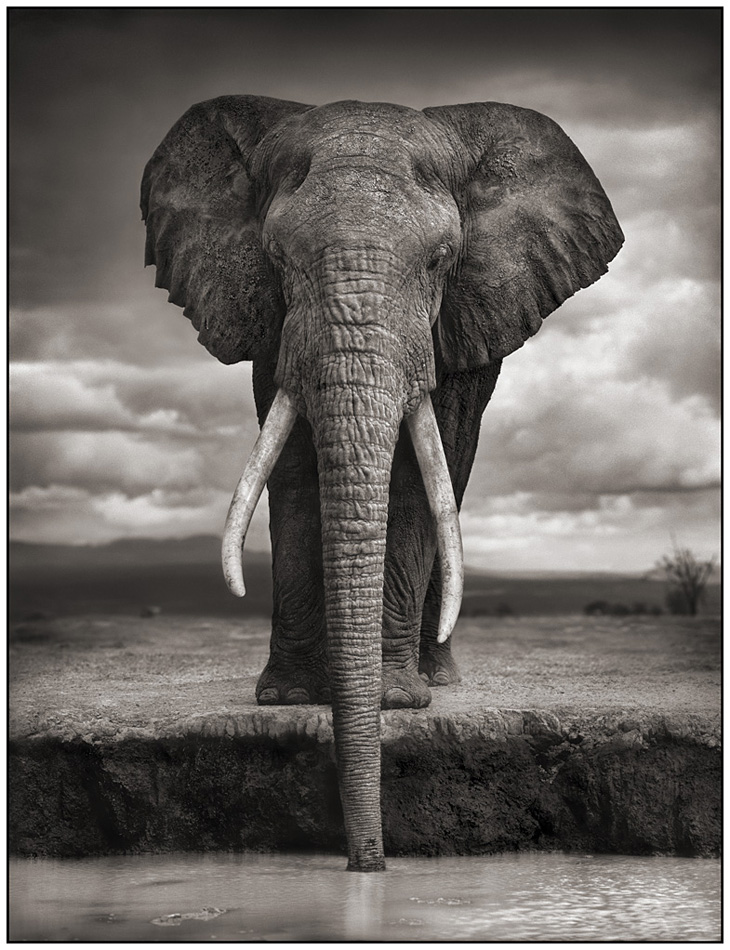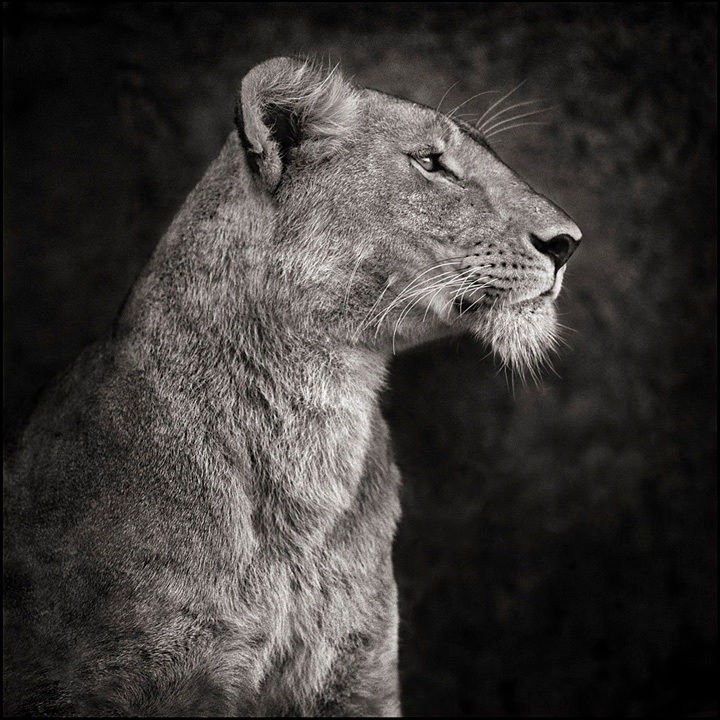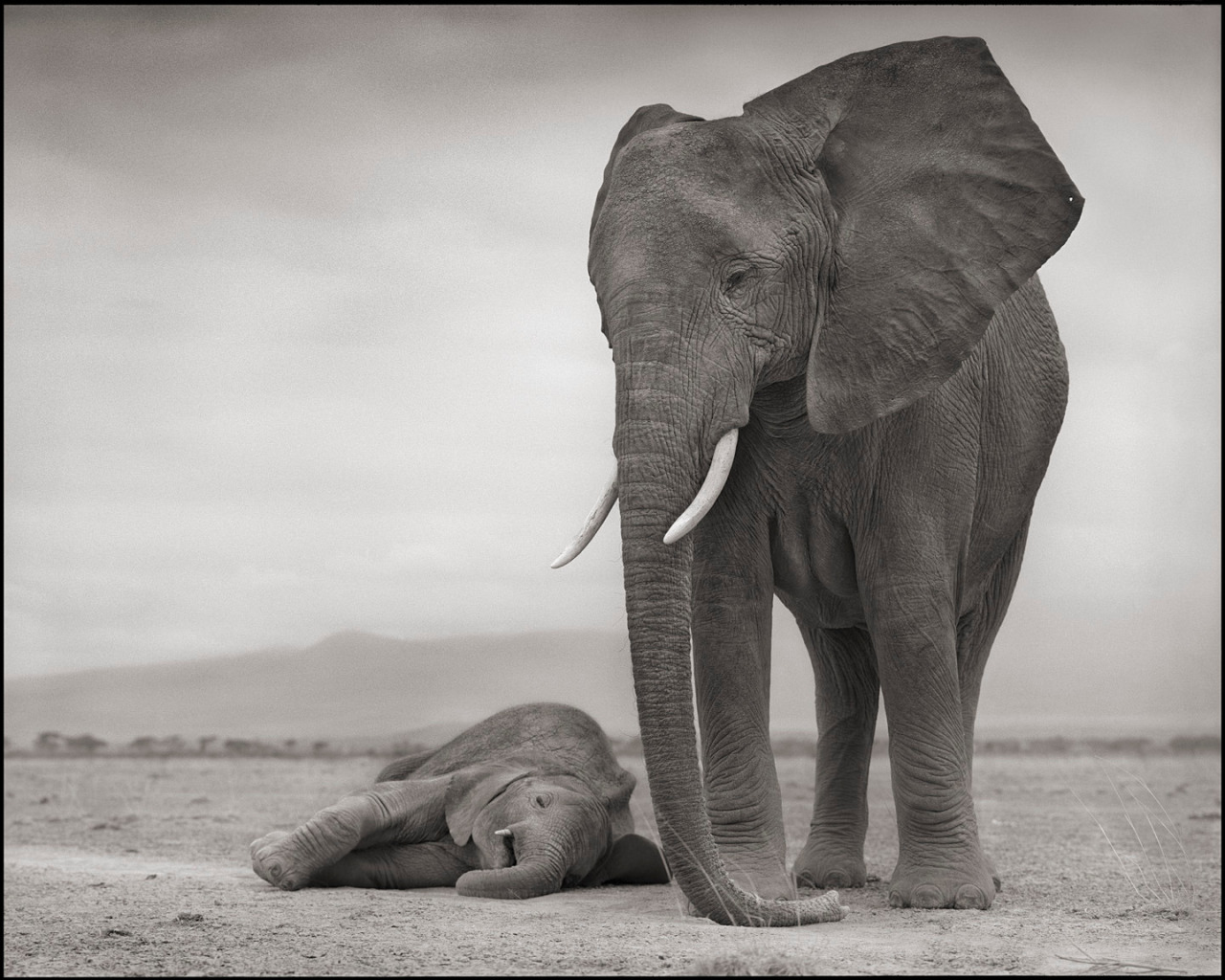On This Earth, A Shadow Falls, Across the Ravaged Land by Nick Brandt Photography
Nick Brandt is a photographer who photographs exclusively in Africa, one of his goals being to record a last testament to the wild animals and places there before they are destroyed by the hands of man. He began as a videographer of music videos for such stars as Michael Jackson, Moby, and Jewel. He was trained in England in painting and film. It was video directing that eventually led him to his current career as an African wildlife photographer. In 1995, while filming in Africa, Brandt became fascinated and fell in love with the wild animals and places. He wanted to capture his feelings about the places and animals but was impossible on video, so he started doing it on photography. Nick no longer directs, he is devoting himself full time to his fine art photography.
Brandt’s pictures of African wildlife are daring: he does not use a telephoto lens, but rather ventures up close to these untamed and dangerous animals. His photos are not purely documentary. Brandt wishes to translate the features of the animals, as well as their spirits, into the photograph.
He is an animal rights activist and a nature preservationist. He started a non-profit organization called the Big Life Foundation, which is dedicated to the conservation of Africa's wildlife and ecosystems. Relying on a grass roots effort, the aim of Big Life Foundation is not only to apprehend poachers but to protect the entire ecosystem, drawing on community collaboration to support conservation, which in turn can support and sustain the community. Now they have 300 rangers, working to protect the animals in the area.
Brandt has had multiple solo gallery and museum shows around the world, including in New York, London, Berlin, Paris and Los Angeles. Born and raised in England, he now lives in the southern Californian mountains.
“On This Earth, A Shadow Falls, Across the Ravaged Land” is a profoundly iconic project started in 2000. The emphasis has generally been on capturing the drama of wild animals IN ACTION, as opposed to simply animals in the state of being.These series of iconic wild animals captured in East Africa are an elegy to the world that is steadily, tragically vanishing.
I had a vision in mind: I wanted to create an elegy, a likely last testament to an extraordinary, beautiful natural world and its denizens that is rapidly disappearing before our eyes. I wanted to show these animals as individual spirits, sentient creatures equally as worthy of life as us.
His ambitious photographic project: a trilogy of books to memorialize the vanishing natural grandeur of East Africa puts forth is that the animals he has photographed are disappearing as they are being both aggressively poached or crowded out by a growing population.
First Book:
On This Earth: Photographs from East Africa
Elephant with Exploding Dust, Amboseli, 2004 © Nick Brandt
Nick Brandt depicts the animals of East Africa with an intimacy and artistry unmatched by other photographers who choose wildlife as their subject. He creates these majestic sepia and blue-tone photos contrasting moments of quintessential stillness with bursts of dramatic action by engaging with these creatures on an exceptionally intimate level, without the customary use of a telephoto lens.
Evocative of classical art, from dignified portraits to sweeping natural tableaux, Brandt's images artfully and simply capture animals in their natural states of being. With a foreword by Alice Sebold and an introduction by Jane Goodall, On This Earth is a gorgeous portfolio of some of the last wild animals and a heartfelt elegy to a vanishing world.
“My images are my elegy to these beautiful creatures, to this wrenchingly beautiful world that steadily, tragically vanishing before our eyes.”
~Nick Brandt
Cheetah and Cubs, Maasai Mara, 2003
Cheetah in Tree, Masai Mara, 2003
Second Book:
A Shadow Falls
Elephant Drinking, Amboseli 2007 © Nick Brandt
In A Shadow Falls, which features fifty-eight recent images in stunning, oversized tritone plates, Nick Brandt continues his ambitious and ongoing photographic project to memorialize the vanishing natural grandeur of East Africa. Brandt’s wide-screen panoramas of animals and landscapes capture an epic vision of Africa that has not been seen before. His iconic portraits of its majestic animals are filled with an empathy usually reserved for human subjects.
From the opening images in A Shadow Falls, of a verdant world filled with multitudes of animals, to the closing images of small bands of creatures moving across a parched, dusty earth, Brandt portrays a mythic Africa struggling against tragic forces. In years to come, we will look back at these powerful photographs and wonder why humanity did not do more to preserve this rare corner of earthly paradise.
“I photograph these animals - that specific elephant or cheetah or lion that has drawn my eye - in the same way I would a human being, watching for the right pose that pose fully will best capture his or her spirit. This means getting close. (Although frustratingly, I can't ask the animals to take a small step to the left, or lift their head a little.) This means getting close. It's one reason why I don't use telephoto lenses. I like to frame the animals within the context of their world - the sky and the landscape - rather than within a telephoto blur or scrubby ground or brushes. Other times, I'm searching for a panoramic view that I hope will convey some semblance of the rare synchronized spectacle of animals, landscape and light that can unfold, if one is very fortunate and patient.”Nick Brandt
The first two volumes of the trilogy were recently combined and published together as “On This Earth, A Shadow Falls,” containing the 90 best photos selected from the first two books.
Lion Before Storm - Sitting Profile, Massai Mara 2006
Cheetah & Cubs Lying on Rock, Serengeti 2007
Portrait of Lioness Against Rock, Serengeti, 2007
Zebras Turning Heads, Ngorongoro Crater 2005
Lions Head to Head, Masai Mara 2008
Nick Brandt discusses this project at Hasted Kraeutler, about his passion for photography, about the experiences encountered taking this pictures and the message that he want’s to share with the world:
Third Book:
Across the Ravaged Land
Across the Ravaged Land is the third and final volume in Nick Brandt’s trilogy of books documenting the disappearing animals of eastern Africa. The book offers a darker vision of this world, still filled with a stunning beauty but now tragically tainted and fast disappearing at the hands of man.
In addition to a range of starkly powerful animal portraits, Brandt introduces some new themes, as humans make an appearance for the first time. He also contributes two essays summing up his photographic odyssey, which has taken more than a decade of intensive work to complete.
Dedicated to the billions of animals, past, present and future, that have died without reason at the hands of man, the book is the culmination of more than a decade of work. Over those years the pulations of elephants, lions, and other large mammals have fallen precipitously, while Brandt’s vision and his attachment to his subjects have intensified. His images of animals resonate with a simple idea: That the sentient creatures in his portraits are not so different from us and have an equal right to live.
A darker theme that reflects what is going in this series, are photos of animal trophies that were killed by hunters.
"From the outset, I had a vision in mind: I wanted to create an elegy, a likely last testament to an extraordinary, beautiful natural world and its denizens that is rapidly disappearing before our eyes. I wanted to show these animals as individual spirits, sentient creatures equally as worthy of life as us." Nick Brandt
In addition to his starkly powerful animal portraits, Brandt explores new themes, as humans make an appearance in his work for the first time in the form of the rangers, whose work it is to protect the animals. He also “repopulates” the epic landscape with remains of animals that he finds or introduces, including hunters’ trophy heads looking out over the lands where they once roamed, and preserved birds and bats calcified in soda lakes, appearing to pose for their portraits, alive again in death. These powerful images evoke the feeling of a staggering loss as well as an intimacy and sentience felt between the animals.
“I chose to photograph in black and white, because aside from the purely aesthetic (the compelling graphic nature of black and white imagery), it accentuates the impression of the images belonging to another much earlier time. As if these animals in the photographs are already long gone, already dead. Photographing with film, as I have done throughout, also gives the images an air of timelessness that digital could not.” Nick Brandt
Nick Brandt decided to end this trilogy with a photograph called elephant footprints. He hopes that mankind will allow the elephants to cross these lands for the generations to come.
The Two Elephants, Amboseli, 2012
Lion & Wildebeest, Amboseli, 2012
Elephant Mother & Baby Sleeping, Amboseli, 2012
Lioness With Cub In Mouth, Amboseli, 2012
Buffalos Head to Head, Lake Nakuru, 2011
Elephant Mother with Baby at Leg, Amboseli, 2012
Elephant Footprints, Amboseli, 2012
The exhibition:
Across the Ravaged Land
Nick Brandt final installment of the trilogy, “Across the Ravaged Land”, is being presented in a noticeably darker tone around the world. The ongoing efforts to document a rapidly disappearing world visualized through the breathtaking monumentality of Africa’s wildlife and its current threats can be discovered in full sized printed images at: HASTED KRAEUTLER GALLERY, New York; FAHEY/KLEIN GALLERY, Los Angeles; PHOTOEYE GALLERY, Santa Fe; SOURCE PHOTOGRAPHICA, Melbourne; A GALERIE, Paris; CAMERAWORK GALLERY, Berlin; ATLAS GALLERY, London and YOUNG GALLERY, Brussels.



























